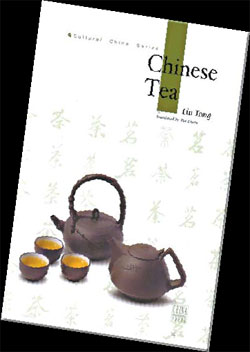| Home / Books & Magazines | Tools: Save | Print | E-mail | Most Read |
| China to a Tea |
| Adjust font size: |
Even as more Chinese begin to take to wine and coffee, tea remains the foremost choice of drink for most Chinese and is deeply rooted in Chinese culture. The English version of Chinese Tea written by Liu Tong and published by the China Intercontinental Press is a well translated text that helps readers understand this culture. The Chinese character currently used for tea, which originated in the Tang Dynasty (AD 618-907), has many interesting connotations. The bottom part represents "wood" (mu); the top is a radical which means "grass"; in between we have "people" (ren). This suggests the harmony between human beings and nature. In ancient times, it was thought that tea plants could not be classified as high-yield or low-yield based on their breeds. The differences were attributed more to growing conditions. Regions with a favorable environment can more often produce rare types of tea. That is why it is said that "famous mountains give birth to famous tea". The mountains listed as heritage sites by the United Nations Educational, Scientific and Cultural Organization (UNESCO) are all famous for tea. To name a few: Rock Tea (Yancha) from Mount Wuyi, East China's Fujian Province, Maofeng from Huangshan of East China's Anhui Province, Cloud-and-Fog (Yunwu) from Lushan of Central China's Jiangxi Province, and Maojian from Wuling of Central China's Hunan Province. To the Chinese, tea embodies a spiritual state of serenity and indifference to fame and fortune. It epitomizes the Chinese philosophies of "remaining tranquil in favor or humiliation" and "contentment brings happiness". In ancient times, it was thought that it was better to involve few people when drinking tea, because as long as there was communication with nature, drinking tea alone could make for a cheerful time. But during the long period of it development, Chinese tea culture has taken on two very different characteristics the upscale and the folksy. While men of letters thought sipping was the essence of tea drinking and taking large gulps spoiled the charm, for ordinary folks, tea was seen primarily as the best thirst reliever. After a hard day's work, workers would come to a simple tea stand and finish a big bowl of tea in one mouthful and then wipe away the tea drops with the back of their hands. This has its own appeal reflecting generosity and heroism. The best place to experience Chinese tea culture is the teahouse. To attract customers, teahouses have always brought together the best tea and invented new ways of drinking. The teahouse was a micro world where people from all walks of life gathered. Chinese writer Lao She (1899-1966) wrote a famous play Teahouse (Cha Guan) in 1956, on the ups and downs of people's lives in the turbulent years between 1898 to 1945. Its dramatized version has been a sensation at the Beijing People's Theater and the Lao She Teahouse has emerged as the most sought-after venue for foreigners to taste a bit of Chinese culture in Beijing. (China Daily March 20, 2007) |
| Tools: Save | Print | E-mail | Most Read |
 |
| Related Stories |
|
